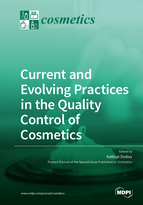Current and Evolving Practices in the Quality Control of Cosmetics
A special issue of Cosmetics (ISSN 2079-9284).
Deadline for manuscript submissions: closed (21 May 2021) | Viewed by 62413
Special Issue Editor
Special Issue Information
Dear Colleagues,
Cosmetic products undergo nowadays rigorous Quality Control testing to ensure that they are safe and stable and that their claims are substantiated by scientifically robust data. Quality Control tests used in the pharmaceutical industry can be applicable also for cosmetic formulations. However, claim substantiation testing is unique to cosmetic products. To enable time- and cost-effective quality control testing, assessment methodologies constantly keep evolving.
This Special Issue calls for manuscripts that explore all stages of Quality Control testing for cosmetic products, i.e., (1) physicochemical stability testing; (2) microbial stability testing; (3) efficacy testing including objective/subjective claim substantiation testing and the evaluation of sensorial properties; (4) toxicological/safety testing with emphasis on current and evolving methodologies that replace animal testing.
Dr. Kalliopi Dodou
Guest Editor
Manuscript Submission Information
Manuscripts should be submitted online at www.mdpi.com by registering and logging in to this website. Once you are registered, click here to go to the submission form. Manuscripts can be submitted until the deadline. All submissions that pass pre-check are peer-reviewed. Accepted papers will be published continuously in the journal (as soon as accepted) and will be listed together on the special issue website. Research articles, review articles as well as short communications are invited. For planned papers, a title and short abstract (about 100 words) can be sent to the Editorial Office for announcement on this website.
Submitted manuscripts should not have been published previously, nor be under consideration for publication elsewhere (except conference proceedings papers). All manuscripts are thoroughly refereed through a single-blind peer-review process. A guide for authors and other relevant information for submission of manuscripts is available on the Instructions for Authors page. Cosmetics is an international peer-reviewed open access semimonthly journal published by MDPI.
Please visit the Instructions for Authors page before submitting a manuscript. The Article Processing Charge (APC) for publication in this open access journal is 1800 CHF (Swiss Francs). Submitted papers should be well formatted and use good English. Authors may use MDPI's English editing service prior to publication or during author revisions.
Keywords
- cosmetic product safety
- stability
- claim substantiation testing
- non animal-testing methodologies






